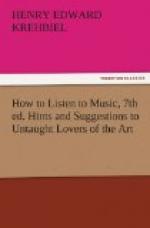FOOTNOTES:
[H] “Notes on the Cultivation of Choral Music,” by H.E. Krehbiel, p. 17.
IX
Musician, Critic, and Public
[Sidenote: The newspapers and the public.]
I have been told that there are many people who read the newspapers on the day after they have attended a concert or operatic representation for the purpose of finding out whether or not the performance gave them proper or sufficient enjoyment. It would not be becoming in me to inquire too curiously into the truth of such a statement, and in view of a denunciation spoken in the introductory chapter of this book, I am not sure that it is not a piece of arrogance, or impudence, on my part to undertake in any way to justify any critical writing on the subject of music. Certain it is that some men who write about music for the newspapers believe, or affect to believe, that criticism is worthless, and I shall not escape the charge of inconsistency, if, after I have condemned the blunders of literary men, who are laymen in music, and separated the majority of professional writers on the art into pedants and rhapsodists, I nevertheless venture to discuss the nature and value of musical criticism. Yet, surely, there must be a right and wrong in this as in every other thing, and just as surely the present structure of society, which rests on the newspaper, invites attention to the existing relationship between musician, critic, and public as an important element in the question How to Listen to Music.
[Sidenote: Relationship between musician, critic, and public.]
[Sidenote: The need and value of conflict.]




